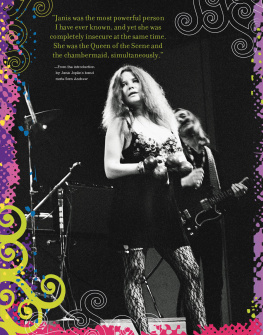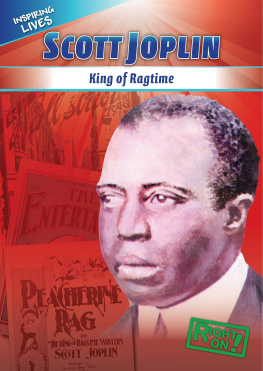

The author and publisher have provided this e-book to you for your personal use only. You may not make this e-book publicly available in any way. Copyright infringement is against the law. If you believe the copy of this e-book you are reading infringes on the authors copyright, please notify the publisher at: us.macmillanusa.com/piracy.
Contents
For my mother
and in memory
of my father
If you dont believe theres a price
For this sweet paradise
Just remind me to show you the scars.
BOB DYLAN
Where Are You Tonight?
Introduction
When Janis Joplin was a small child her mother found her one night outside on the sidewalk sleepwalking away from their house. Janis, what are you doing? she shouted after her daughter. Where are you going? Her question was one the Joplins would surely want to ask their wayward daughter many times in the future, but then Janis simply said, Im going home. Im going home. Even as a child, Janis seemed to know it was a bad match, that her home just couldnt be the oil refinery town of Port Arthur, Texas.
Janis stopped sleepwalking, but she never stopped moving. The small child setting out for home alone in the middle of the nightthere couldnt be a more poignant and true image of the singer whose life and music were defined by restlessness. You can hear the restlessness in her incredible wall-of-sound voice. Janis wasnt content merely to hit a note right; she trained her voice to sound as if she were singing two notes simultaneously. And while most white blues musicians played respectful and faithful renditions of the classics, Janiss blues were slash-and-burn assaults, screeches and screams of bewilderment and despair at lifes many injustices, among them her own terrible loneliness. In the end, home was a place Janis glimpsed but never really found, remaining instead curiously unanchored throughout her life. One close friend called her the most obvious, best-publicized homeless person of the sixties, so palpable was her loneliness.
But Janiss alienation was more than a personal estrangementit was the experience of a generation. She went through all the changes we did, said Jerry Garcia when she died. She went on all the same trips. She was just like the rest of usfucked up, strung out, in weird places. Garcia may have been exaggerating the similarities, but certainly Janiss journey was not hers alone. Along with many other wannabe beatniks, Janis spent years on the road emulating Jack Kerouac, paving the way for the counterculture. Crisscrossing the country, bohemian kids lived like nomads, sailing, as Tom Wolfe observed, like gypsies along the Service-center fringes of America.
When they did settle for a while, it was in Americas crumbling inner-city neighborhoods, San Franciscos Haight-Ashbury, for example, where Janis landed in the midsixties. While her parents had participated in the largest migration of American historythe postWorld War II urban exodusJanis and her drop-out friends pioneered a reverse migration back to the cities their parents had abandoned. In contrast to the generations of immigrants forced to live in ghettoes as they pursued the American Dream, the hippies came to the ghetto fleeing America. For them, as for the Beats before them, constant motion and identification with the downtrodden served to fend off the blandness, conventionality, and hyperdomesticity of the fifties. Theirs was a way of life underwritten by Americas extraordinary affluence but predicated on the conviction that wealth and comfort bred spiritual and emotional impoverishment and strangled all authenticity and soulfulness. Money doesnt talk, it swears, sneered Bob Dylan.
Rootless, unattached, and defiant, Janis was the quintessential nobodys girl, a position that was both liberating and painful. She craved motion; it was such an exhilarating distractionfrom herself and from the hurts that plagued her, from her agonizing coming of age in Port Arthur. And stardom brought Janis all kinds of motion, but it also intensified her loneliness as life became a blur of hotel rooms, dressing rooms, airports, and bars; dressed outrageously, her wild mane bedecked with pink and blue feathers, her arms loaded with bracelets that jangled away noisily, Janis was set apart, frequently an object of admiration but often of ridicule and scorn. Although she thumbed her nose at straight society, Janis still desperately wanted to be liked, even by those she despised. If she bristled at having her independence compromised by intimate relationships, she nevertheless despaired at belonging to no one. Like other rebels of her time, Janis rejected rigid categories of identity; in her world, racial and sometimes even sexual categories were disdained as straitjackets. Janis, however, took experimentation further than most, pursuing sex with men and women, proclaiming herself the first white-black person, and drinking and carousing like one of the boys. There was wild pleasure in all her freedom, but there were costs as well. Janis tried to shield herself from the abuse that followed her rebelliousness by projecting a tough-girl ballsiness, but the put-downs and insults hit home nevertheless.
Much of Janiss pain stemmed from her desire to be somebody at a time when girls were supposed to be satisfied nabbing Mr. Right. Janis wanted to nab Mr. Right, too, but she wanted something else as well. On more than one occasion she admitted no guy ever made me feel as good as an audience. But hers was an uncharted path and she moved down it unsteadily. Janis may have been a rebel (the first girl at the University of Texas to go braless, or so legend has it), but she was never able to break fully with the orthodoxies of the fifties. And in truth, virtually no onenot even the most determined rebelsescaped the fifties unscathed. What makes Janiss rebelliousness particularly remarkable is that she was so far ahead of her time, refusing to be a good girl long before the revival of modern feminism legitimized such refusal. In 1967, when Janis began commanding headlines, the first womens liberation groups had not yet formed, and career and family still seemed utterly unreconcilable for women. And when it came to relations between men and women, even the counterculture wasnt really counter. Janiss struggle would have been hard enough had she just set out to be a successful pop singer, but she was also trying to carve out a space for herself in a culture where the only sanctioned role for a woman was as her mans old lady.
Janis may have been nobodys girl, but she didnt die a nobody. In the end, the pig of Port Arthur became rocks first female superstara reversal of fortune that Janis always relished. Indeed, like her idol Bessie Smith, Janis was the very embodiment of the dynamic of reversal so central to blues musicthe making of nobodies into somebodies. In a reflective moment Janis once pondered what strange, weird events had brought her to this place. As usual, she minimized her talent, suggesting that every fucking conceivable thing brought it all together to make this strange person, this chick who was good at this one thing, man, just this one fucking thing. She had lost a lot along the way, she said, adding, I may never get it back. But she never gave up. I know I aint quittin, she insisted. Janis suffered tremendous losses, but neither those nor the tragedy of her death can dwarf her achievements or her spirit, which was nothing if not resilient.
* * *
Before Janis Joplin, there was another Janis, Janis Martin. In 1956, fifteen-year-old Janis Martin scored a top-ten hit for RCA with Will You, Willyum. Just months before signing Martin, whod been performing since she was eleven, RCA had paid Sun Records the unprecedented sum of $25,000 for Elvis Presleys contract. Within weeks, someone at RCA had the bright idea of capitalizing on Elviss success by billing Martin the female Elvis, a moniker approved by both Elvis and his manager, Colonel Tom Parker. At first the formula seemed to work, as Martin broke into the Top 10 again with the rockabilly tune My Boy Elvis. But Martin never really found a niche. Country audiences were often put off by rock n roll moves theyd found adorable in her when she was a child but deemed vulgar and unseemly in a young lady. Martin claims that despite her love of R & B and rock n roll, she was pushed toward country. Her RCA promo shot, however, offers some more-likely clues about why her career as a rock n roller faltered. One look at the earnest, guitar-strumming Martin, and its obvious that if there could have been a female Elvis, she wasnt it. While everything about Elvis, from his sneer and his long, pomaded, dyed black hair to his pumping pelvis, signaled he was a boy from the wrong side of the tracks, Martin evoked the wholesomeness of the girl next door. In truth, the effort to market her as the female analogue to Elvis was bound to fail. Fifties girlsblack or whitecould never have achieved stardom by staking out the same sexually transgressive territory that Elvis had so effortlessly claimed. After all, this was postwar America, where girls were supposed to be sexy, not sexual. How fitting, then, that RCA dropped Martin in 1958 on learning shed been secretly married at fifteen and was now pregnant.
Next page









